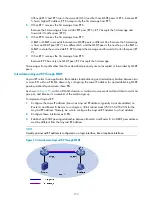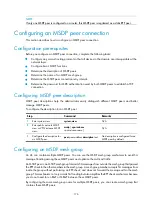
186
Configured Up Listen Connect Shutdown Down
1 1 0 0 0 0
Peer's Address State Up/Down time AS SA Count Reset Count
192.168.3.1 Up 01:07:08 200 8 0
# Display the detailed MSDP peer information on Router B.
[RouterB] display msdp peer-status
MSDP Peer Information of VPN-Instance: public net
MSDP Peer 192.168.1.2, AS 200
Description:
Information about connection status:
State: Up
Up/down time: 00:15:47
Resets: 0
Connection interface: Pos5/0 (192.168.1.1)
Number of sent/received messages: 16/16
Number of discarded output messages: 0
Elapsed time since last connection or counters clear: 00:17:51
Information about (Source, Group)-based SA filtering policy:
Import policy: none
Export policy: none
Information about SA-Requests:
Policy to accept SA-Request messages: none
Sending SA-Requests status: disable
Minimum TTL to forward SA with encapsulated data: 0
SAs learned from this peer: 0, SA-cache maximum for the peer: none
Input queue size: 0, Output queue size: 0
Counters for MSDP message:
Count of RPF check failure: 0
Incoming/outgoing SA messages: 0/0
Incoming/outgoing SA requests: 0/0
Incoming/outgoing SA responses: 0/0
Incoming/outgoing data packets: 0/0
Inter-AS multicast configuration by leveraging static RPF peers
Network requirements
As shown in
, the network has two OSPF ASs: AS 100 and AS 200. BGP runs between the two
ASs.
PIM-SM 1 belongs to AS 100, and PIM-SM 2 and PIM-SM 3 belong to AS 200. Each PIM-SM domain
has at least one multicast source or receiver.
Configure Loopback 0 as the C-BSR and C-RP of the related PIM-SM domain on Router A, Router D and
Router G.
According to the RPF principle, the routers can receive SA messages that pass the filtering policy from its
static RPF peers. To share multicast source information among PIM-SM domains without changing the
unicast topology structure, configure MSDP peering relationships for the RPs of the PIM-SM domains and
















































